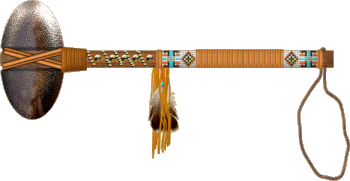
Chief Cornstalk
Biography in part by Lyn Cornwell
Background artwork by Chief Hawk Pope
“Keigh Tugh Qua” “Hokolesqua” “Colesqua” translated to mean “blade of corn” in reference to his height of over 6’.
*1720-1777
*Principal Chief of the Shawnee Nation 1755-1777
*Head Chief of Northern Confederacy 1760-1774
*Described as a handsome, intelligent, honorable man.
*Murdered by Whites while on a peace mission to Fort Randolph, Point Pleasant, WV.
There is very little information about his early years. He was most likely born in Pennsylvania, which was the home of the Shawnee in the early 1700’s.
During the French and Indian War, Cornstalk and the Shawnees sided with the French. They feared that English settlers would come rapidly into the Ohio Country if they were not stopped. Cornstalk led raiding parties into western Virginia, hoping to drive the English away from Shawnee territory. He also played an active part in Pontiac's Rebellion in 1763. Colonel Henry Bouquet defeated the Shawnee in 1764. To assure that the natives would sign a peace treaty ending the rebellion, Bouquet seized several hostages, including Cornstalk. The Shawnee agreed not to take up arms against the English again.
During the next decade, fighting did occur between the English and the Ohio natives. Cornstalk tried to peacefully ease the tensions, but the arrival of more white settlers placed him in the minority as to how to deal with the whites. By the spring of 1774, violence was constant. On May 3, 1774, a group of English colonists killed eleven Mingo Indians. At least two of them were relatives of Logan, a leader of the Mingos in the Ohio Country. Upon hearing of the murders, many Mingos and Shawnees demanded retribution. Some, like Cornstalk, urged conciliation. Cornstalk and most other Shawnee Indians promised to protect English fur traders in the Ohio Country from retaliatory attacks since the traders were innocent. Logan, however, was not easily convinced, and Shawnee and Mingo chiefs permitted him to attack the parties responsible for his family members' murders -- British colonists living south of the Ohio River.
Logan took approximately two dozen warriors to exact revenge on the colonists. He did not go into Kentucky. Rather he traveled into western Pennsylvania. There, his followers killed thirteen settlers before returning back across the Ohio River. Captain John Connolly, commander of Fort Pitt, immediately prepared to attack the Ohio Country natives. John Murray, Lord Dunmore, the royal governor of Virginia, offered his colony's assistance. Dunmore hoped to prevent Pennsylvania's expansion into modern-day West Virginia and Kentucky. He believed the best way to do this was to place Virginia militiamen in these regions. He also hoped to benefit by opening these lands to white settlement.
In August 1774, Pennsylvania militia entered the Ohio Country and quickly destroyed seven Mingo villages, which the Indians had abandoned as the soldiers approached. At the same time, Lord Dunmore sent one thousand men to the Kanawha River in modern-day West Virginia to build a fort and attack the Shawnees. Cornstalk, who had experienced a change of heart about the white colonists as the soldiers invaded the Ohio Country, dispatched nearly one thousand Shawnee warriors to drive Dunmore's force from the region. The forces met on October 10, 1774, at what became known as the Battle of Point Pleasant. After several hours of intense fighting, the English drove Cornstalk's followers north of the Ohio River. Dunmore, with a separate force, followed the Shawnees across the river into the Ohio Country. Upon nearing the Shawnee villages on the Pickaway Plains, Dunmore stopped and asked that the Shawnees discuss a peace treaty with him. The Shawnees agreed, but while negotiations were under way, Colonel Andrew Lewis, and a detachment of Virginia militia that Dunmore had left behind at Point Pleasant, crossed the Ohio River and destroyed several Shawnee villages. Fearing that Dunmore intended to destroy them, the Shawnees immediately agreed to terms before more blood was shed.
Under this new treaty, the Shawnee Indians agreed to the terms of the Treaty of Fort Stanwix (1768). They had to give up ownership to all lands east and south of the Ohio River. This was the first time that natives that actually lived in the Ohio Country agreed to relinquish some of their land. In addition, the Shawnees promised to return all white captives and to no longer attack English colonists traveling down the Ohio River.
Cornstalk abided by this treaty for the rest of his life. Most Shawnees did not. By 1777, the Shawnee Indians again planned to drive the white settlers from the region. This time they did so at the urging of British soldiers who sought assistance in defeating the colonists in the American Revolution. Cornstalk and his son, Elinipsico, went to Point Pleasant, the site of an American fort, to warn the whites of the impending attack. The Americans took the natives hostage. Shortly thereafter, news reached Point Pleasant that, the Shawnee had ambushed and killed an American soldier. Seeking vengeance, the colonists killed Cornstalk, his son, and other natives in American custody.
Cornstalk illustrates the division of the Native Americans in the Ohio Country. Even within the same tribe, members could not agree on how to deal with white settlers moving into the area.
Please visit our website at
Return to American Indian History
Some Pictures Courtesy of The Greasy Grass Graphics